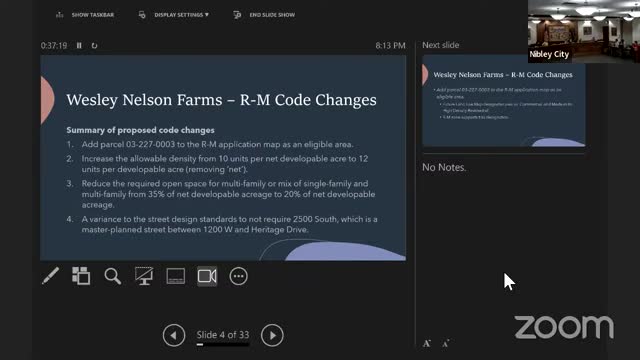Council debates affordable housing amid rising development costs
August 23, 2024 | Nibley City Council, Nibley , Cache County, Utah
This article was created by AI summarizing key points discussed. AI makes mistakes, so for full details and context, please refer to the video of the full meeting. Please report any errors so we can fix them. Report an error »

In a recent government meeting, council members discussed the challenges and implications of proposed residential developments in the area, particularly focusing on density and affordability. The conversation highlighted a significant shift from previous proposals, where the council had rejected plans to reduce the required area for residential planned unit developments (RPUD) to below 40 acres.
The current proposal involves a 13.16-acre parcel, which has raised concerns about the feasibility of implementing higher density housing while maintaining adequate open space. Council members noted that the smaller size of the property complicates efforts to achieve the desired density without compromising quality of life for residents.
A key point of discussion was the need for multifamily housing as opposed to single-family homes, with proponents arguing that the latter would not be financially viable due to high land and development costs. The council acknowledged that the rising prices of single-family homes, which can exceed $600,000, make them unaffordable for many residents.
The conversation also touched on the broader issue of housing affordability in the region, with council members expressing concern over the increasing difficulty for potential homebuyers to qualify for mortgages. The state defines affordable housing as costing no more than 30% of a household's area median income, a benchmark that many current developments fail to meet.
As the council continues to navigate these complex issues, the focus remains on balancing the need for increased housing density with the imperative of affordability, ensuring that new developments serve the community's needs without exacerbating existing challenges.
The current proposal involves a 13.16-acre parcel, which has raised concerns about the feasibility of implementing higher density housing while maintaining adequate open space. Council members noted that the smaller size of the property complicates efforts to achieve the desired density without compromising quality of life for residents.
A key point of discussion was the need for multifamily housing as opposed to single-family homes, with proponents arguing that the latter would not be financially viable due to high land and development costs. The council acknowledged that the rising prices of single-family homes, which can exceed $600,000, make them unaffordable for many residents.
The conversation also touched on the broader issue of housing affordability in the region, with council members expressing concern over the increasing difficulty for potential homebuyers to qualify for mortgages. The state defines affordable housing as costing no more than 30% of a household's area median income, a benchmark that many current developments fail to meet.
As the council continues to navigate these complex issues, the focus remains on balancing the need for increased housing density with the imperative of affordability, ensuring that new developments serve the community's needs without exacerbating existing challenges.
View full meeting
This article is based on a recent meeting—watch the full video and explore the complete transcript for deeper insights into the discussion.
View full meeting

